Ravens, like many animal species, have their own ways of attracting mates and maintaining social relationships. However, a recent discovery has revealed an intriguing aspect of raven intelligence and communication abilities: they use gestures such as their beaks and wings to attract partners and build relationships. According to a study published on November 29, 2023, in the journal Nature Communications, ravens can use their beaks and wings to make special gestures, even holding up objects as a sign of interest (Griffin, Lermitte, & Gallup, 2023)

This discovery not only marks an exciting scientific event but also changes the way we perceive animal communication abilities. “This behavior may be the foundation for the development of language and symbols, much like how small children begin to communicate with the world around them,” the researchers stated. Previously, this behavior was believed to be characteristic of primates, but now ravens have shown that they also possess the ability to use gestures to establish relationships and communicate.
This study is the result of a two-year survey conducted at Cumberland Wildpark in Grünau, Austria. The scientists tracked the behavior of individually marked ravens, and throughout the period, they observed that ravens use their beaks to point to objects, suggesting they are not only capable of observing but also able to use signs to interact with each other. This might lead us to consider whether these behaviors could signal the development of language or even the formation of symbols.
“This study shows that ravens can communicate with each other through gestures similar to humans, broadening our understanding of animal intelligence,” according to scientists from the University of Cambridge (2022).
The fact that ravens use gestures to communicate also opens up many fascinating hypotheses about the development of animal language and how they may express intentions, emotions, or needs. This gesture is not only a tool to attract mates but may also be used to reinforce existing relationships, helping ravens maintain bonds within their community.
When we look at other animal species, especially primates, communication through gestures has long been documented. However, ravens, a bird species not typically known for complex communication, have now shown that this ability is not limited to primates. This raises questions about the cognitive abilities and intelligence of other animal species in the wild. It is possible that we will see more and more animals exhibiting complex communication behaviors similar to those of ravens.
Along with ravens using their beaks and wings to communicate, scientists can now expand their research on how this communication affects the formation of social structures and relationships in the animal kingdom. These discoveries may help us understand more about the development of language, symbols, and could even lead to a shift in how we view the intelligence of animals.


HPX24h > Animals > Ravens Use Gestures to Find Mates: A New Discovery About Their Intelligence
Top Reads from This Category
Animals
The Stunning Image of a Cheetah in Action During Its Hunt
Animals
Why Bedbugs Thrive Through Inbreeding
Animals
Stickleback Fish’s Secret to Adapting from Saltwater to Freshwater: How Genetic Mutations Enable Remarkable Adaptation
Animals
Rats Help Each Other: When Compassion Emerges from Small Creatures
Animals
Gibbons Develop Vocal Techniques as Powerful as Humans: New Discoveries About Their Unique Sounds
Animals
Unexpected Science: When Seismologists Listen to Underwater Earthquakes and Discover Whale Songs
Animals
Explaining How Mosquitoes Can Fly Through a Rainstorm
Discover New Topics
Parenting Tips
How to Talk to Your Child About Drugs Effectively
Healthy Eating
Ways to Reduce Sugar in Your Diet to Prevent Diabetes
Animals
Can Hyena Dogs Be as Smart as Primates?
Parenting Tips
Why You Can’t Force Your Child to Live the Way You Do?
Health
Why You Shouldn’t Skip a Protein-Rich Breakfast
Animals
Secrets to Surviving Antarctic Freezing Cold Through RNA Editing
Science
Artificial Hearts and a Future Without the Need for Transplants
Science
New Hope from Cyborg Spinal Implant Technology for Paralyzed Patients
Science
Science Uncovers the Brain’s Process of Storing New Ideas
Science
Turning Dreams On and Off with Brain-Control Technology: A Breakthrough in Sleep Researc
Fitness
Rest the Right Way: When to Take a Rest Day and How to Spend It?
Science
NSF Cuts 168 Jobs Amid Booming Science and Technology: Paradox or Strategic Move?
Science
Why Cultured Meat Could Be the Future of the Food Industry